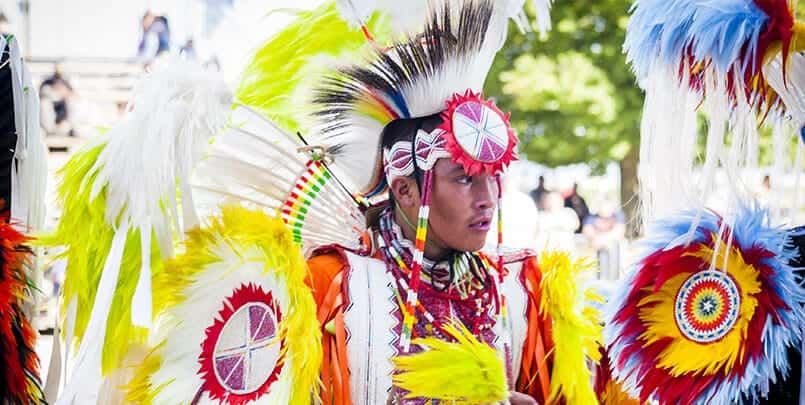The 2016 annual Indian Summer Festival in Milwaukee, Wis., celebrated its 30th year anniversary this month.
The festival began bright and early Friday morning. As many Native people find their way towards the powwow, the festival actually has many other events that are both educational and cultural to Native Americans and other non-Native people. Friday is known as “Education Day”, as its sole purpose is to educate those of the original ways of the Native aboriginals to America.
Many tribes from around the state including The Ho-Chunk, Oneida Nation, Brothertown, Ojibwe, and even Potawatomi. These tribes have gathered to teach certain traditional ways towards the audience that was attracted to these events. Such events are as follows: Fire Making using a bow drill, Clan game, Iroquois Storytelling and Social Dancing, Plants used for food and medicine, moccasin game, Praying ceremonies, Lacrosse, a way of showing how the woodland and great lakes living styles used to be, etc. A lot of these traditions are those that sustained us in the past before modern times and still do to this day.
The Indian Summer Festival isn’t only known for its traditional teachings; therefore, a lot of the events are aimed towards people to gather and see how the Native Aboriginals lived back in the day, witness tribal groups box, and also attend social gatherings by listening to many Native and non-Native American performers. Some of the people attending are very well-known either throughout their tribes, around the state, throughout the national powwow committee, or even MTV famous such as performer Supaman (Christian Parrish).
Supaman is from the Apsáalooke Nation in Montana. He is a modern-day hip hop artist that includes a Native American-styled sound while also placing a lot of his lyrics towards the concepts of modern-day issues such as the DAPL, Back 40 mine, suicide crisis towards the Plains Indians, etc. He was a pleasure to meet and talk to. He is a very well-known fancy dancer and is known amongst almost all tribes and NAC members because his father was the first president when the American Indian Religious Freedom Act was passed in 1978.
Having the pleasure to meet certain people that are known for putting their voice into modern-day issues was interesting. Many people at Indian Summer were also wearing shirts that showed support to the Indian community, especially towards the west in the Dakotas against the Dakota access pipeline.
Throughout the history of Indian Summer, many people have come around to see the traditional and cultural values of Native Americans; however, the festival has allowed many other indigenous cultures to perform and show their cultural music, dances, languages, and even prayers. This person could be from the Amazonas, the Andes Mountains from Peru and Ecuador, to the Aztec and Mayan descendants from Central America and Mexico. A lot of diversity has shown the greatness of Indian summer. The festival every year is getting bigger and bigger with more attendants and diversity.
The powwow was a great turnout throughout the weekend. My family lineage is that of the Potawatomi and Ho-Chunk nations. The powwow was spectacular and I’m glad I was raised in the dancing circle through most of my life. My Ho-Chunk families, the Whiteclouds, are known throughout all of Indian Country due to their unique style of beadwork, regalia, and dancing techniques. As a matter of fact, my grandfather, Johnny Whitecloud, was the world’s championship dancer for many years.
Not being able to dance this summer because of education commitments, I was delighted to dance again but even happier when I was able to dance with my family. The aroma of the arena with its essence really does brighten your spirit. Seeing many faces from very young babies to the golden-age dancers really makes you appreciate the value in powwows. The people that you see that go from powwow to powwow knowing you by memory or even childhood memories makes you smile. Seeing how excellent of a dancer one has become since he or she was little is awesome. I’ve witnessed this with tribal members here in the Potawatomi tribe and others from different tribal nations.
The dancing is exciting to watch; my favorite to watch is men’s fancy. Seeing friends and family dancing in the category is spectacular to watch as the speed of the dancers increases faster and faster until out of nowhere it will stop – making the dancers stop (most of the time) in their tracks. They really have to time their steps; otherwise, they could be overstepping on songs.
My family really does know how to make a powwow good; either it’s eating together, braiding each others’ hair, or even just talking or watching other dancers is perfect.
Indian Summer was a success, especially towards my Ho-Chunk family. All of my aunts in the women’s categories placed first. A lot of my family placed in the powwow, which tells me that they really are known for their dancing. I hope someday to be known in the Indian Country for something good. In order to be known, I’ll have to do well in life. By this, I will succeed.

